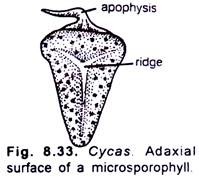In this article we will discuss about:- 1. Characters of Bombacaceae 2. Distribution of Bombacaceae 3. Economic Importance 4. Affinities 5. Important Type.
Characters of Bombacaceae:
Tall trees with mucilage cells, flowers hermaphrodite, hypogynous, anthers bithecous or polythecous; steminodes absent, pollen gains smooth; carpels 2-5, syncarpous, erect, anatropous ovules. Seeds smooth.
A. Vegetative characters:
Habit:
Tall trees with thick trunks.
Root:
Tap, branched.
Stem:
Erect, thick, branched, resin ducts and mucilage cells present.
Leaf:
Simple or palmately compound, alternate, stipulate, stipule caducous vesture of stellate hairs or peltate scales (lepidote), entire or digitate.
B. Floral characters:
Inflorescence:
Flowers solitary or fasiculate.
Flower:
Actimomophic, hypogynous, hermaphrodite, large, showy, commonly bracteate, often appearing before the leaves, sometimes subtended by an involucre.
Calyx:
Sepals 5, connate in a capular calyx, valvate, inferior.
Corolla:
Petals 5 or occasionally absent, contorted in bud, imbricate.
Androecium:
Stamens 5-many, free or monadelphous, anthers monothecal or bithecal or polythecal, staminodes often present.
Gynoecium:
Carpels 2-5, syncarpous. Ovary superior, bi-to penta locular, axile placentation, ovules anatropous; style 1, capitate or lobed, stigma 1-5.
Fruit:
Loculicidal capsule (Sometimes an indehiscent pod) or berry like. Seed – Smooth, sometimes embedded in pith-like tissue or in a woolly proliferation of the pericarp, occasionally arillate.
Pollination:
Entomophilous, due to nectar at the base of petal and large gaudy flowers.
Floral formula:
Distribution of Bombacaceae:
It is extensively tropical family of 22 genera and 140 species.
Economic Importance of Bombacaceae:
1. Food:
Durio zebethinus Murr. yields the ‘Durian fruit’ much esteemed by the Burmese. The immature calyx of Salmalia malaburilla (Syn. Bombax malabaricum) provides “Somargulla” a vegetable in Uttar Pradesh.
The acid pulp of the fruits of Adansonia digitata make a good beverage.
2. Medicine:
The bark of Adansonia is used as a substitute of quinine and the leaves and fruit pulp as febri fuge.
3. Silk cotton:
The Seed hairs of Salmalia malabarica (Syn. Bombax madabaricum D.C.) are Simul or silk cotton and are used in stuffing pillows, quilts and cushions. The best cotton is derived from Cieba pentandra.
4. Timber:
The timber obtained from Ochroma lagopus S.W. is very light and soft, specific gravity 0.12, the lightest wood in the world and best known as ‘Balsa’.
5. Ornamentals:
The species of Bombax, Adansonia & Ceiba are grown as ornamentals.
Primitive characters:
1. Tree habit.
2. Leaves alternate and stipulate.
3. Presence of mucilage cells in all parts of the plant.
4. Flowers actimorphic and hermaphrodite.
5. Corolla chloripetalous.
6. Pollen grains large in size and smooth-walled.
7. Large number of stamens.
8. Ovules many and anatropous.
9. Fruit large and sometimes woody.
Advanced characters:
1. Leaves compound.
2. Flowers in definite inflorescence.
3. Flowers Cyclic.
4. Calyx gamosepalous.
5. Androecium monadelphous and anthers monothecous.
6. Gynoecium bi-to penta-carpellary syncarpous.
7. Axile placentation.
8. Fruit capsule.
9. Reduction in number of stamens (5 in Ceiba pentandra) and capels to 2 or 3.
Affinities of Bombacaceae:
In Bombucaceae the stamen morphology of many plants reveals primitive character like Dilleniaccae and tribe Paonieae of the family Ranunculaceae. Pollen smooth, never spiny like Malvaceae.
Bombacaceae is closely allied to the Malvaceae and the Sterculiaceae, from which it is distinguished by the smooth pollen gains, anthers bitheceus or polythecous, staminodes present, and the pericarp of the fruit pithy to wooly.
Common plants of the family:
1. Adansonia digitata L. – Baobab tree-A fantastic looking tree.
2. Bombax malabaricum D.C. (syn. Salmalia malabarica) – Silk cotton tree, it loses its foliage in December and it bursts into a blaze of scarlet flowers upon the marked branches in January.
3. Ceiba pentandra – White silk-cotton vern. Kapok.
Important Type of Bombacaceae:
Bombax malabaricum (syn. Salmalia malabarica):
Habit:
A tall deciduous tree, the lower part of the tree usually buttressed.
Root:
Tap and branched.
Stem:
Erect, stout, branches whorled, spreading horizontally, young stem covered with conical pickles which disappear with age.
Leaf:
Glabrous, digitately compound; leaflets 5-7, shortly stalked, lanceolate 10-20 cm long, pointed.
Inflorescence:
Solitary or fasicled.
Flower:
Large, red, occasionally white, hermaphrodite, hypogynous, actinomorphic, bracteate.
Calyx:
Sepals 5, basally connate, valvate, inferior, leathery, falling off with the corolla.
Corolla:
Petals 5, thick oblong, 8-16 cm, tomentose outside, pubescent or glabrous within.
Androecium:
Stamens °s in three series about half as long as petals, outer ones united near base in five bundles, 10 intermediate shorter, 5 innermost forked near the top.
Gynoecium:
Carpels 5, syncarpous, superior, pentalocular, styles united near the top stigmatic along their free ends.
Fruit:
Capsule, woody, oblong, 10 to 12 cm, splitting by 5 valves from top.
Seed:
Indefinite in number, smooth, enveloped in fine silky-wool.
Floral formula:
